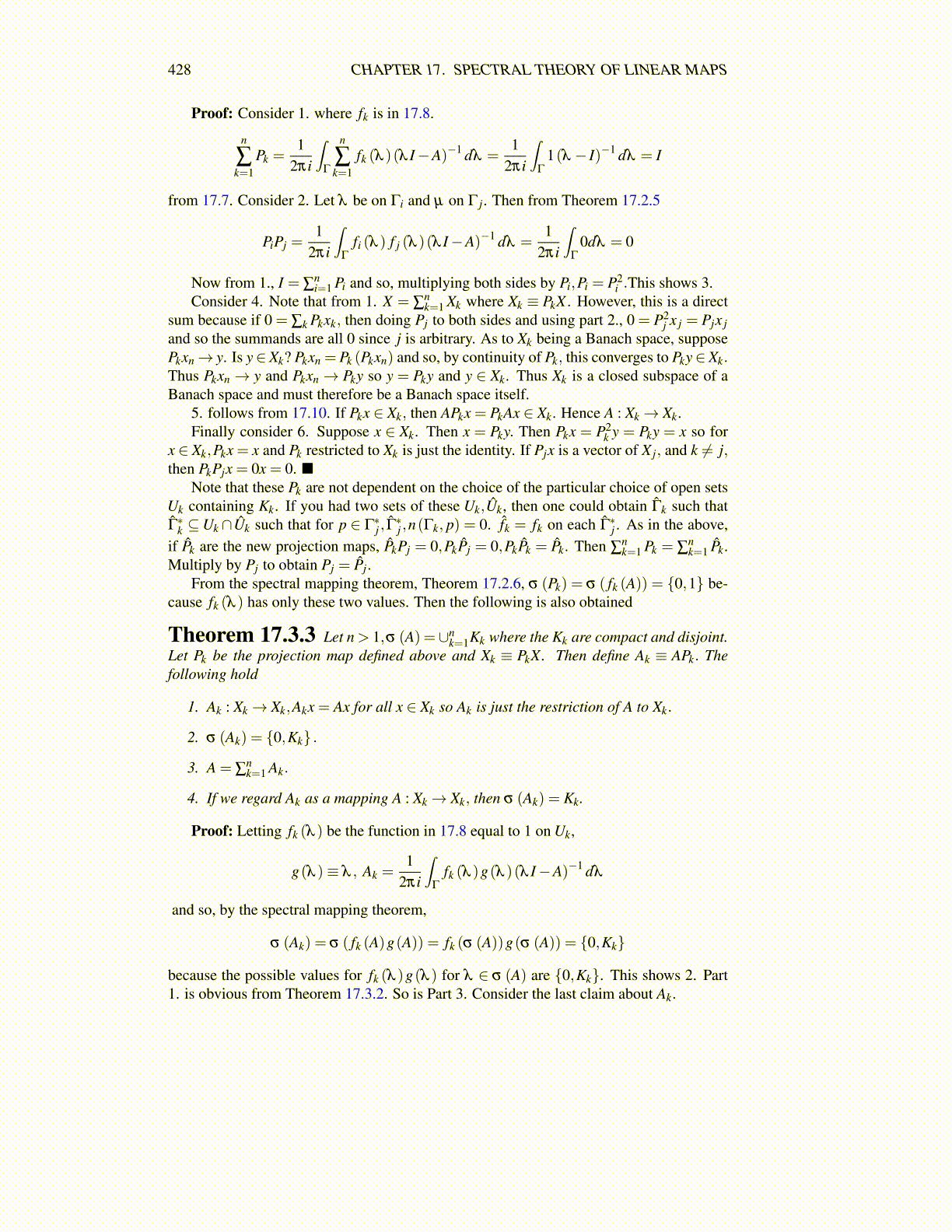
428 CHAPTER 17. SPECTRAL THEORY OF LINEAR MAPS
Proof: Consider 1. where fk is in 17.8.
n
∑k=1
Pk =1
2πi
∫Γ
n
∑k=1
fk (λ )(λ I−A)−1 dλ =1
2πi
∫Γ
1(λ − I)−1 dλ = I
from 17.7. Consider 2. Let λ be on Γi and µ on Γ j. Then from Theorem 17.2.5
PiPj =1
2πi
∫Γ
fi (λ ) f j (λ )(λ I−A)−1 dλ =1
2πi
∫Γ
0dλ = 0
Now from 1., I = ∑ni=1 Pi and so, multiplying both sides by Pi,Pi = P2
i .This shows 3.Consider 4. Note that from 1. X = ∑
nk=1 Xk where Xk ≡ PkX . However, this is a direct
sum because if 0 = ∑k Pkxk, then doing Pj to both sides and using part 2., 0 = P2j x j = Pjx j
and so the summands are all 0 since j is arbitrary. As to Xk being a Banach space, supposePkxn→ y. Is y∈ Xk? Pkxn = Pk (Pkxn) and so, by continuity of Pk, this converges to Pky∈ Xk.Thus Pkxn → y and Pkxn → Pky so y = Pky and y ∈ Xk. Thus Xk is a closed subspace of aBanach space and must therefore be a Banach space itself.
5. follows from 17.10. If Pkx ∈ Xk, then APkx = PkAx ∈ Xk. Hence A : Xk→ Xk.Finally consider 6. Suppose x ∈ Xk. Then x = Pky. Then Pkx = P2
k y = Pky = x so forx ∈ Xk,Pkx = x and Pk restricted to Xk is just the identity. If Pjx is a vector of X j, and k ̸= j,then PkPjx = 0x = 0. ■
Note that these Pk are not dependent on the choice of the particular choice of open setsUk containing Kk. If you had two sets of these Uk,Ûk, then one could obtain Γ̂k such thatΓ̂∗k ⊆Uk ∩Ûk such that for p ∈ Γ∗j , Γ̂
∗j ,n(Γk, p) = 0. f̂k = fk on each Γ̂∗j . As in the above,
if P̂k are the new projection maps, P̂kPj = 0,PkP̂j = 0,PkP̂k = P̂k. Then ∑nk=1 Pk = ∑
nk=1 P̂k.
Multiply by Pj to obtain Pj = P̂j.From the spectral mapping theorem, Theorem 17.2.6, σ (Pk) = σ ( fk (A)) = {0,1} be-
cause fk (λ ) has only these two values. Then the following is also obtained
Theorem 17.3.3 Let n > 1,σ (A) =∪nk=1Kk where the Kk are compact and disjoint.
Let Pk be the projection map defined above and Xk ≡ PkX. Then define Ak ≡ APk. Thefollowing hold
1. Ak : Xk→ Xk,Akx = Ax for all x ∈ Xk so Ak is just the restriction of A to Xk.
2. σ (Ak) = {0,Kk} .
3. A = ∑nk=1 Ak.
4. If we regard Ak as a mapping A : Xk→ Xk, then σ (Ak) = Kk.
Proof: Letting fk (λ ) be the function in 17.8 equal to 1 on Uk,
g(λ )≡ λ , Ak =1
2πi
∫Γ
fk (λ )g(λ )(λ I−A)−1 dλ
and so, by the spectral mapping theorem,
σ (Ak) = σ ( fk (A)g(A)) = fk (σ (A))g(σ (A)) = {0,Kk}
because the possible values for fk (λ )g(λ ) for λ ∈ σ (A) are {0,Kk}. This shows 2. Part1. is obvious from Theorem 17.3.2. So is Part 3. Consider the last claim about Ak.